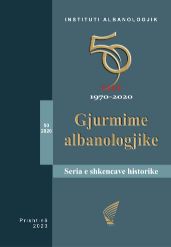MONUMENTI MBIVARROR I VAJZËS SË RE DARDANE NGA PEQANI I SUHAREKËS
AN ANTIQUE TOMBSTONE OF THE YOUNG DARDANIAN GIRL FROM PEQANI VILLAGE OF SUHAREKA
Author(s): Naser FerriSubject(s): Archaeology, Gender Studies, Ancient World, 6th to 12th Centuries
Published by: Instituti Albanologjik i Prishtinës
Keywords: stela dardane; Dardani; Therandë; dardane women; dardane onomastics; romanization;
Summary/Abstract: In the village of Peqan, between the villages of Semetisht and Sllapuzhan near Suhareka, during July 2019 a monument from the Roman period was found. This monument, so called “dardanian tipe stela” is made of limestone, with dimensions: 177 x 64 x 28.5 cm. and has three main parts: the aedicula, the inscription field and the part below the inscription field where there is a pot -cantaros with a lion-shaped handle and out of the vessel come two vines with ivy leaves surrounding the inscription field on all sides and separates it from the aedicula, which is decorated with two acroteria on the side and probably there was a pinecone in the middle which is missing. In the aedicula are two human busts: a woman and a young girl, dressed in the traditional dress of the Dardanian women but with their heads uncovered (otherwise, on most of these "Dardaniantype" of stelas, women's heads are covered with large scarves), while in the inscription field with dimensions; 58 x 34.5 cm the text is stored in 8 lines: DM / VLP MATA /QVE VIXIT /ANN XV / 5 AEL ANDIA/ FILIE MEAE/ PIISIME POSVI /. It is understood from the text of the inscription that the monument in question was erected by the mother Aelia Andia to his daughter Ulpia Mata who had died at the age of fifteen. The type of monument, ethno-cultural and onomastic elements prove that Ulpia Mata and Elia Andia belonged to the social class of the rich Dardanian population in the process of Romanization after several centuries of armed and peaceful resistance of the Dardanians against Roman occupation and Romanization, while in chronological terms the stela found in Peqan belongs to the golden period after the time of rule, reforms and consolidation of the Roman Empire by the emperors Trajan and Hadian, therefore they belong to the end of the IIo or the beginning of the IIIo century during which period the Roman Empire and the provinces, and in this context Dardania and the Theranda region had experienced the peak of development and prosperity. These monument as well as other findings from different historical epochs in the region of Suhareka prove the importance of this region, thanks to its geographical and strategic position, during different during various prehistoric and historical periods (Neolithic, Eneolithic, Iron Age, Antiquity, early Christianity of the Middle Ages).
Journal: Gjurmime Albanologjike - Seria e shkencave historike
- Issue Year: 2020
- Issue No: 50
- Page Range: 19-36
- Page Count: 18
- Language: Albanian
- Content File-PDF

